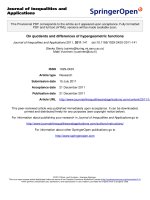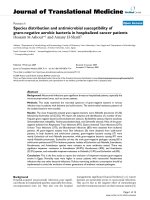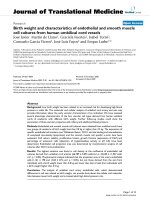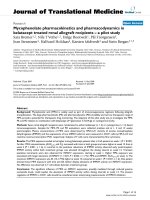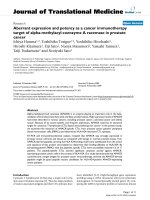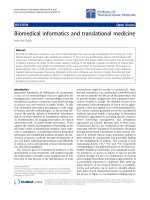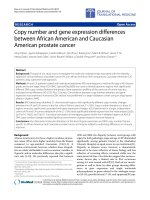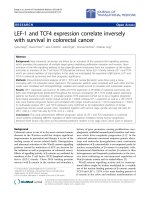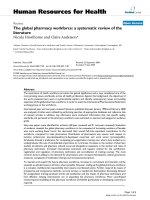báo cáo hóa học: " Multiple myeloma and farming. A systematic review of 30 years of research. Where next?" pdf
Bạn đang xem bản rút gọn của tài liệu. Xem và tải ngay bản đầy đủ của tài liệu tại đây (401 KB, 7 trang )
BioMed Central
Page 1 of 7
(page number not for citation purposes)
Journal of Occupational Medicine
and Toxicology
Open Access
Review
Multiple myeloma and farming. A systematic review of 30 years of
research. Where next?
Carla Perrotta*
1
, Anthony Staines
2
and Pierlugi Cocco
3
Address:
1
School of Public Health and Population Science, University College Dublin, Woodview House, Belfield, Dublin 4, Ireland,
2
School of
Nursing, Dublin City University, Glanesvin, Dublin 9, Ireland and
3
Department of Public Health, Occupational Health Section, University of
Cagliari, Italy
Email: Carla Perrotta* - ; Anthony Staines - ; Pierlugi Cocco -
* Corresponding author
Abstract
Background: Multiple myeloma has been linked to farming for over thirty years. However, there
is little clarity about the magnitude of the risk, nor about the specific agricultural exposures which
contribute to the risk.
Methods: We have carried out a systematic review of case-control studies of multiple myeloma
published from 1970 to October 2007. Studies were identified through database searches and from
references in the literature.
Studies reporting risk estimates from farming, agricultural exposures, and exposure to animals
were identified, and details abstracted. The impact of study heterogeneity, publication bias,
variation in methods of case identification and exposure ascertainment between studies were
considered in analysis.
Results: Case control studies showed a pooled odds ratio (OR) for working as a farmer of 1.39
95% CI 1.18 to 1.65. There was no graphic evidence of publication bias, for pesticide exposure 1.47;
95% 1.11 to 1.94, for DDT 2.19; CI 95% 1.30 to 2.95; for exposed to herbicides 1.69; 95 %CI 1.01
to 1.83. For working on a farm for more than ten years OR was 1.87; 95% CI 1.15 to 3.16.
Conclusion: Farmers seem to have increase risk for MM. However, a major limitation of this
analysis is the presence of significant heterogeneity across the studies and the evidence of
publication bias in some models.
A pooled analysis using individual level data could provide more power and permit the
harmonization of occupational and exposure coding data.
Background
Multiple myeloma (MM) is a non-Hodgkin's lymphoma
(NHL) with a number of distinctive clinical and biological
features, which distinguish it from other members of the
NHL family.
The disease is uncommon in younger people, but the inci-
dence rises steeply from the age of 65. There is a marked
male predominance. There is very substantial variation in
incidence between different countries with the lowest
incidence rates amongst in Asia and highest rates in
wealthy countries, and especially in the black population
in North America. [1,2]
Published: 17 November 2008
Journal of Occupational Medicine and Toxicology 2008, 3:27 doi:10.1186/1745-6673-3-27
Received: 13 June 2008
Accepted: 17 November 2008
This article is available from: />© 2008 Perrotta et al; licensee BioMed Central Ltd.
This is an Open Access article distributed under the terms of the Creative Commons Attribution License ( />),
which permits unrestricted use, distribution, and reproduction in any medium, provided the original work is properly cited.
Journal of Occupational Medicine and Toxicology 2008, 3:27 />Page 2 of 7
(page number not for citation purposes)
Over the last thirty years, more than sixty studies have
been carried out into the etiology of multiple myeloma. In
contrast to the immense progress in understanding the
biology of this disease, and in the development of new
therapies, for most patients, little can be said about the
possible causes. No useful public health interventions
have been identified which might reduce the incidence of
this disease, or the individual risk of this disease.
Most of the work on the etiology of MM focuses on under-
standing potential risks associated with long term envi-
ronmental and job related exposures. Several occupations
and exposures have been related to MM, notably working
in agriculture, printing services and some specific chemi-
cal industries such as plastic and rubber.
We present a meta analysis of case control studies of occu-
pation and MM. This first article reports our analyses of
those studies reporting the effect of farming and other
agricultural exposures. Our goal is to clarify what is pres-
ently known, and to provide a context for designing the
next generation of epidemiological studies on myeloma.
Farming and Multiple Myeloma
Farming has been consistently associated with an
increased risk of MM since 1970 when Milham (1970) [3]
reported a higher than expected number of MM deaths
amongst American farmers. Khuder and Mutgi (1997)[4]
published a meta analysis of farm employment and MM
and assessed 32 case control and cohort studies done
between 1981 and 1996.
The pooled analysis of the OR from individual papers
(both case control and cohort studies) showed a relative
risk of 1.23, with a 95% confidence interval (95% CI) of
1.14 to 1.32 for the association between MM and farming.
A sub group analysis of female farmers reported a RR of
1.38; 95% CI 1.27 to 1.43. The sub group of thirteen
cohort studies had a pooled RR of 1.13; 95% CI 1.09 to
1.17. However, they did not include an analysis of any
particular agricultural exposures it combined case control
and cohort studies and it did not report the presence of
heterogeneity in those models. Since then, a number of
important new studies have been conducted and further
efforts have been made to identify possible agricultural
exposures.
Our goal was to do a meta analysis of all case control stud-
ies on farming occupations published since 1970.
Methods
Search Strategy
PUBMED and the Cochrane Library were searched and we
carried out further manual searching of reference lists of
articles. The PUBMED search strategy used was (Mye-
lom*$, Multiple Myeloma$, Plasmocytoma$, Plasmocy-
tom$, or Plasmacytom$, Mieloma$, Lymphomas, Non-
Hodking lymphomas .ti.ab.) AND (Job exposure or occu-
pational exposure or Agricultural or farmers or farming or
pesticides or glyphosate or dichloro-diphenyl-trichlo-
roethane or insecticides or meat workers or occupational,
or environmental exposure) ti.ab. We also explored the
terms "controlled-study"/all sub headings (control or
controls or controlled) with (trial* or study or studies) in
title and abstracts and (evaluation or prospective*) with
(trial* or study or studies) and (cohort or prospective
studies). Studies that did not report separately on cases of
MM were excluded as were papers with preliminary data.
There was no specific restriction on study inclusion based
on quality scores. If two publications from the same study
population were published we selected the most recent
analysis for inclusion. Studies were searched from 1970
until October 2007. No language restriction was made.
Analysis
For each case control study included we identified the job
titles used for farmers and the nature and level of detail of
agricultural exposures recorded. We extracted the odds
ratio and associated confidence intervals for the following
categories: "farmers", "agricultural or animal husbandry
workers", "agricultural workers", pesticides exposure
(ever/never), specific pesticides, and working as a farmer
for more than ten years.
Consistency between studies was checked using the
Cochran Q test under the null hypothesis that all studies
have the same effect [5]. If heterogeneity was identified
studies were excluded first according to their design (that
is exposure extracted from death certificates or cancer reg-
istry data vs. personal interview), then year of publication
(before 1999 vs., after 1999) and continent of origin
(Europe vs. rest of the world).
Random effects models were used to estimate the pooled
OR and the associated confidence interval for each spe-
cific exposure or job title. The adjusted estimate was
included in the pooled analysis.
Funnel plots were drawn to evaluate potential publication
bias [6]. All the analyses were done using Stata, version 9.
Results
Studies retrieved
Fifty five relevant studies were selected out of 530 cites
obtained using this broad search strategy.
From the fifty five studies identified, 28 case control stud-
ies reported estimates for farming and/or agricultural
related exposures. [3,7-32] (Additional file 1).
Journal of Occupational Medicine and Toxicology 2008, 3:27 />Page 3 of 7
(page number not for citation purposes)
Studies description
Researchers used a range of methods to identify cases.
These included routinely collected death certificates, and
death certificates from the American Cancer Society Pro-
spective Study. In all the other studies, cases were reported
to cancer registries or identified as incident cases in indi-
vidual hospitals (additional file 1). Controls were
matched by age and gender in all the studies. Reporting of
estimates separately for women was done in three studies
[7,13,30].
Occupational assessment was done using either job title
or occupation as recorded on the death certificate
[3,11,12,25,32], surveys [8], occupation registries
[21,30]or using standardized interviews [3,7,9,10,13-
20,22,24,26,28,29,31] Four studies [8,15,23,33] reported
duration of occupation in categories.
Exposure assessment varied across these studies. Most
used a detailed occupational history and obtained further
information from job-specific questionnaires and some of
them used hygienists to assess exposures from occupation
history. [7,13,21,23,30] The specific exposures reported in
the case control studies were pesticide exposure in general
[7,8,16,21,24,29,30]; exposure to specific pesticides such
as DDT [16,26], chlorophenols [16,26]; herbicides
[27,29,33] and working with specific animals.
Farming
It was possible to extract the odds ratio and confidence
interval from 21 case control studies. There was a 33%
increase in the risk for ever working as a farmer (OR 1.39;
95% CI 1.18 to 1.65) (fig 1). There was significant heter-
ogeneity in this model (p = 0.002). Heterogeneity per-
sisted when analyzing European studies vs. rest of the
world studies, and within Europe, Scandinavian countries
vs. non-Scandinavian countries, and those studies done
before and after 1999.
Sub group analysis was done according to the method
used to ascertain occupation and according to co variables
including obtaining the estimates.
The risk in those studies that ascertained occupation using
death certificates was increased (OR 1.25; 95% CI 1.03 to
1.52) (fig 1) as well as those seven studies that adjusted
for level of education (OR 1.28; 95% CI 1.02 to 1.62)
None of this two models have presence of heterogeneity.
We did a further subgroup analysis for ten or more years
working on a farm (OR 1.87; 95% CI 1.11 to 3.16) (test
for heterogeneity p = 0.021) (Figure 2).
Pesticides
Seven case control studies [7,8,16,21,24,29,30] reported
pesticide exposure (analyzed here as ever or never occupa-
tionally exposed). Ever being exposed to pesticides had
increase risk (OR 1.47; 95% CI 1.11 to 1.94, with evidence
of heterogeneity and publication bias (test for heterogene-
ity p = 0.090). (Figure 3, additional file 3).
Few studies reported on specific pesticides groups. DDT
exposure had an increase risk [16,26] (OR 2.19; 95% CI
1.30 to 2.95); herbicide exposures were also reported sep-
arately in three studies [7,27,29] with no increase in the
risk (OR 0.97; 95% CI 0.68–1.38) (results not shown).
Two compounds showed high estimates in individual
studies: phenoxyacetics (OR 2.2; 95% CI 1.15–4.66 and
chlorophenols (OR 2.4; 95% CI 1.0–5.9).
Animal farming
Four studies reported OR for working with different ani-
mals [7,16,26,29].
The risk was increase for working in a farm with sheep
(OR 1.71; 95% CI 1.25–2.33); [16,29]; horses (OR 1.72;
95% CI 1.26–2.37) [16,26];and, dairy cattle (OR 1.59;
95% CI 1.26–2.01) [7,16,26,29] (results not shown).
These results should be taken with caution as all of the
models have graphic evidence of publication bias (results
not shown).
Discussion
There is consistent evidence from studies in many differ-
ent countries over nearly thirty years for an association
between working on a farm and multiple myeloma. A pre-
vious meta-analysis published in 1997 summarized the
evidence at that time. [4]
Pooling data with the new case control studies further
confirms the association between farming and MM (OR
1.39; 95% CI 1.18 to 1.65). The association is not strong
but it is very consistent over many years in several differ-
ent countries. However, the presence of heterogeneity was
significant in most of the models. The main source of het-
erogeneity seems to be study design, adjustment for level
of education in the individual studies estimates and the
different farming techniques and pesticide use around the
world and across the decades.
For a more specific study of 'agricultural exposures', there
is now substantial published data on exposures to pesti-
cides but not strong evidence on working with animals.
Ever being exposed to pesticides have a 46% increase in
risk. Exposure to DDT, chlorophenols and phenoxy-acetic
acids were all associated with an excess risk in case-control
studies of MM patients.
These results should be taken with caution as the presence
of publication bias was significant in both models work-
ing with animals and exposure to pesticide.
Journal of Occupational Medicine and Toxicology 2008, 3:27 />Page 4 of 7
(page number not for citation purposes)
Plotting the standard error of the OR over the OR gives an
asymmetric figure suggesting reporting bias, as authors are
much more likely to report exposures with statistically sig-
nificant odds ratios.
It is possible that there are a number of unpublished neg-
ative studies, and that if these were available our conclu-
sions would be modified.
A major limitation of this meta analysis is that we did not
included cohort studies. However, pooling the cohort
studies that were included in the Kruger meta analysis
plus the cohort studies that were published after its publi-
cation [34,35] gave an relative risk of 1.12 (95%CI 1.09 to
1.16) with strong evidence of heterogeneity (p = 0.006) as
well in the models.
The Agricultural Health Study; a large ongoing cohort
study set in the US, has produced five publications so far
on the risk of MM and specific pesticides. None of these
associations has reached statistical significance, and it
may be that more follow up time from these cohorts will
be needed. As MM has a well defined pre malignant state
Individual and pooled OR for farming and Multiple Myeloma from published case control studiesFigure 1
Individual and pooled OR for farming and Multiple Myeloma from published case control studies.
Journal of Occupational Medicine and Toxicology 2008, 3:27 />Page 5 of 7
(page number not for citation purposes)
(MGUS) the study of MGUS in agricultural cohorts could
lead to interest results in the future.
All observational studies are subject to a range of method-
ological problems that are more severe, and far less tracta-
ble, than those affecting clinical trials. Methodological
checklists for case-control study quality assessment have
been developed, but these have yet to achieve widespread
use [36]. Adoption of a formal meta-analytic approach, as
done here, can be viewed as simply providing a conven-
ient tool for summarizing the result of a large number of
studies. It is, at least, useful.
Are there public health implications from our work? The
hazards of farming both in developed and developing
countries are well established. There is no current evi-
dence that the individual risk of myeloma can be modi-
fied. It is possible that the very largest cohort studies will
record farming practices in sufficient detail, and accrue
enough cases of myeloma, to permit an effective analysis,
but this will take many decades. Public health advice,
while accepting the scanty evidence base, could probably
focus first on minimizing the use of agro-chemicals, and
then on the use of protective equipment by applicators.
This review shows the limitations of how observational
studies report their results; as an example it would have
been interesting to analyze the effect of exposure on
females and males separately but it was not feasible as few
studies reported estimates for gender categories.
Future systematic reviews will need to pool individual
level data from as many studies as possible, which would
permit a much more robust analysis, and the ability to
adjust odds ratios for variables not considered in the orig-
inal analysis as well as the possibility of harmonization of
the occupational and exposure categories. Future case-
control studies of myeloma will need to be an order of
magnitude bigger than all current studies, and will need
very refined exposure assessment if they are to contribute
to progress.
Farming and Multiple Myeloma, meta analysis of case control studies: Individual and pooled odds ratio, category "Working as a farmer for more than ten years"Figure 2
Farming and Multiple Myeloma, meta analysis of case control studies: Individual and pooled odds ratio, cate-
gory "Working as a farmer for more than ten years".
Journal of Occupational Medicine and Toxicology 2008, 3:27 />Page 6 of 7
(page number not for citation purposes)
Conclusion
Farmers seem to have increase risk for MM. Pesticides
rather than animal exposure seems to be a possible risk
factor. However, a major limitation of this analysis is the
presence of significant heterogeneity across the studies
and the evidence of publication bias in some models.
Level of education seems to be an important co variable
and should be considered in studies analysing occupa-
tion.
A pooled analysis using individual level data could pro-
vide more power and permit the harmonization of occu-
pational and exposure coding data.
Abbreviations
MM: Multiple Myeloma; OR: odds ratio; 95%CI: 95%
Confidence Interval
Competing interests
The authors declare that they have no competing interests.
Authors' contributions
CP has carried out the data extraction, performed the sta-
tistical analysis and drafted the manuscript, AS conceived
the study and helped to draft the manuscript, PC partici-
pated in the writing on the manuscript.
Additional material
Additional file 1
Table 1. Farming and Multiple Myeloma, meta analysis of observational
studies control studies: Description of case control studies
Click here for file
[ />6673-3-27-S1.doc]
Additional file 2
figure 1. Farming and Multiple Myeloma, meta analysis of case control
studies. Funnel plot. Ever/never working as a farmer
Click here for file
[ />6673-3-27-S2.doc]
Farming and Multiple Myeloma, meta analysis of case control studies: individual and pooled estimates, category "ever exposed to pesticides"Figure 3
Farming and Multiple Myeloma, meta analysis of case control studies: individual and pooled estimates, cate-
gory "ever exposed to pesticides".
Publish with Bio Med Central and every
scientist can read your work free of charge
"BioMed Central will be the most significant development for
disseminating the results of biomedical research in our lifetime."
Sir Paul Nurse, Cancer Research UK
Your research papers will be:
available free of charge to the entire biomedical community
peer reviewed and published immediately upon acceptance
cited in PubMed and archived on PubMed Central
yours — you keep the copyright
Submit your manuscript here:
/>BioMedcentral
Journal of Occupational Medicine and Toxicology 2008, 3:27 />Page 7 of 7
(page number not for citation purposes)
Acknowledgements
This research project was funded by: Health Research Board, Ireland and
Cancer Research Ireland.
References
1. Ferlay J, Bray F, Pisani P, Parkin DM: GLOBOCAN 2002. In Cancer
Incidence, Mortality and Prevalence Worldwide ARCPress, Lyon; 2004.
2. Ries LAG, Melbert D, Krapcho M, Mariotto A, Miller BA, Feuer EJ, et
al.: SEER Cancer Statistics Review, 1975–2004, National Can-
cer Institute. Bethesda, MD. based on November 2006 SEER data
submission, posted to the SEER web site, 2007 2008 [http://
www.seer.cancer.gov].
3. Milham S Jr: Leukemia and multiple myeloma in farmers. Am
J Epidemiol 1971, 94:507-510.
4. Khuder SA, Mutgi AB: Meta-analyses of multiple myeloma and
farming. Am J Ind Med 1997, 32:510-516.
5. Dersimonian R, Laird N: Meta-analysis in clinical trials. Control
Clin Trials 1986, 7:177-188.
6. Egger M, Davey Smith G, Schneider M, Minder C: Bias in meta-
analysis detected by a simple, graphical test. BMJ 1997,
315(7109):629-634.
7. Baris D, Silverman DT, Brown LM, Swanson GM, Hayes RB, Schwartz
AG, et al.: Occupation, pesticide exposure and risk of multiple
myeloma. Scand J Work Environ Health 2004, 30:215-222.
8. Boffetta P, Stellman SD, Garfinkel L: A case-control study of mul-
tiple myeloma nested in the American Cancer Society pro-
spective study. Int J Cancer 1989, 43:554-559.
9. Brown LM, Burmeister LF, Everett GD, Blair A: Pesticide expo-
sures and multiple myeloma in Iowa men. Cancer Causes Con-
trol 1993, 4:153-156.
10. Brownson RC, Reif JS: A cancer registry-based study of occupa-
tional risk for lymphoma, multiple myeloma and leukaemia.
Int J Epidemiol 1988, 17:27-32.
11. Burmeister LF: Cancer in Iowa farmers: recent results. Am J Ind
Med 1990, 18:295-301.
12. Cantor KP, Blair A: Farming and mortality from multiple mye-
loma: a case-control study with the use of death certificates.
J Natl Cancer Inst 1984, 72:251-255.
13. Costantini AS, Miligi L, Kriebel D, Ramazzotti V, Rodella S, Scarpi E,
et al.: A multicenter case-control study in Italy on hematol-
ymphopoietic neoplasms and occupation. Epidemiology 2001,
12:78-87.
14. Cuzick J, De SB: Multiple myeloma – a case-control study. Br J
Cancer 1988, 57:516-520.
15. Demers PA, Vaughan TL, Koepsell TD, Lyon JL, Swanson GM, Green-
berg RS, et al.: A case-control study of multiple myeloma and
occupation. Am J Ind Med 1993, 23:629-639.
16. Eriksson M, Karlsson M: Occupational and other environmental
factors and multiple myeloma: a population based case-con-
trol study. Br J Ind Med 1992, 49:95-103.
17. Flodin U, Fredriksson M, Persson B: Multiple myeloma and
engine exhausts, fresh wood, and creosote: a case-referent
study. Am J Ind Med 1987, 12:519-529.
18. Franceschi S, Barbone F, Bidoli E, Guarneri S, Talamini R, La VC: Can-
cer risks in farmers:results from a multi-site case-control
study in north-eastern Italy. Int J Cancer 1993, 53:740-745.
19. Fritschi L, Siemiatycki J: Lymphoma, myeloma and occupation:
results of a case-control study. Int J Cancer 1996, 67:498-503.
20. Gallagher RP, Spinelli JJ, Elwood JM, Skippen DH: Allergies and agri-
cultural exposure as risk factors for multiple myeloma. Br J
Cancer 1983, 48:853-857.
21. Heineman EF, Olsen JH, Pottern LM, Gomez M, Raffn E, Blair A:
Occupational risk factors for multiple myeloma among Dan-
ish men. Cancer Causes Control 1992, 3:555-568.
22. La VC, Negri E, D'Avanzo B, Franceschi S: Occupation and lym-
phoid neoplasms. Br J Cancer 1989, 60:385-388.
23. Mester B, Nieters A, Deeg E, Elsner G, Becker N, Seidler A: Occu-
pation and malignant lymphoma: a population based case
control study in Germany. Occup Environ Med 2006, 63:17-26.
24. Morris P, Koepsell TD, Dailing JR, Taylor JW, Lyon JL, Swanson GM,
et al.:
Toxic substance exposure and Multiple Myeloma: A
case -control study. J Natl Cancer Inst 1986, 76(6):987-994.
25. Nandakumar A, Armstrong BK, de Klerk NH: Multiple myeloma
in Western Australia: a case-control study in relation to
occupation, father's occupation, socioeconomic status and
country of birth. Int J Cancer 1986, 37:223-226.
26. Nanni O, Falcini F, Buiatti E, Bucchi L, Naldoni M, Serra P, et al.: Mul-
tiple myeloma and work in agriculture: results of a case-con-
trol study in Forli, Italy. Cancer Causes Control 1998, 9:277-283.
27. Pahwa P, McDuffie HH, Dosman JA, Robson D, McLaughlin JR, Spinelli
JJ, et al.: Exposure to animals and selected risk factors among
Canadian farm residents with Hodgkin's disease, multiple
myeloma, or soft tissue sarcoma. J Occup Environ Med 2003,
45:857-868.
28. Pasqualetti P, Casale R, Collacciani A, Colantonio D: [Work activi-
ties and the risk of multiple myeloma. A case-control study].
Med Lav 1990, 81:308-319.
29. Pearce NE, Smith AH, Howard JK, Sheppard RA, Giles HJ, Teague
CA: Case-control study of multiple myeloma and farming. Br
J Cancer 1986, 54:493-500.
30. Pottern LM, Heineman EF, Olsen JH, Raffn E, Blair A: Multiple mye-
loma among Danish women: employment history and work-
place exposures. Cancer Causes Control 1992, 3:427-432.
31. Sonoda T, Ishida T, Mori M, Sakai H, Noguchi M, Mori M, et al.: A
case-control study of multiple myeloma in Japan: association
with occupational factors. Asian Pac J Cancer Prev 2005, 6:33-36.
32. Svec MA, Ward MH, Dosemeci M, Checkoway H, De Roos AJ: Risk
of lymphatic or haematopoietic cancer mortality with occu-
pational exposure to animals or the public. Occup Environ Med
2005, 62:726-735.
33. Blair A, Dosemeci M, Heineman EF: Cancer and other causes of
death among male and female farmers from twenty-three
states.
Am J Ind Med 1993, 23:729-742.
34. Lee E, Burnett CA, Lalich N, Cameron LL, Sestito JP: Proportionate
mortality of crop and livestock farmers in the United States,
1984–1993. Am J Ind Med 2002, 42:410-420.
35. Pukkala E, Notkola V: Cancer incidence among Finnish farmers,
1979–93. Cancer Causes Control 1997, 8:25-33.
36. Elm Ev, Altman DG, Egger M, Pocock SJ, Gotzsche PC, Vanden-
broucke JP, et al.: Strengthening the reporting of observational
studies in epidemiology (STROBE) statement: guidelines for
reporting observational studies. BMJ 2007, 335:806-808.
Additional file 3
figure 2. Farming and Multiple Myeloma, meta analysis of case control
studies. Funnel Plot. Ever/never pesticide exposures.
Click here for file
[ />6673-3-27-S3.doc]
